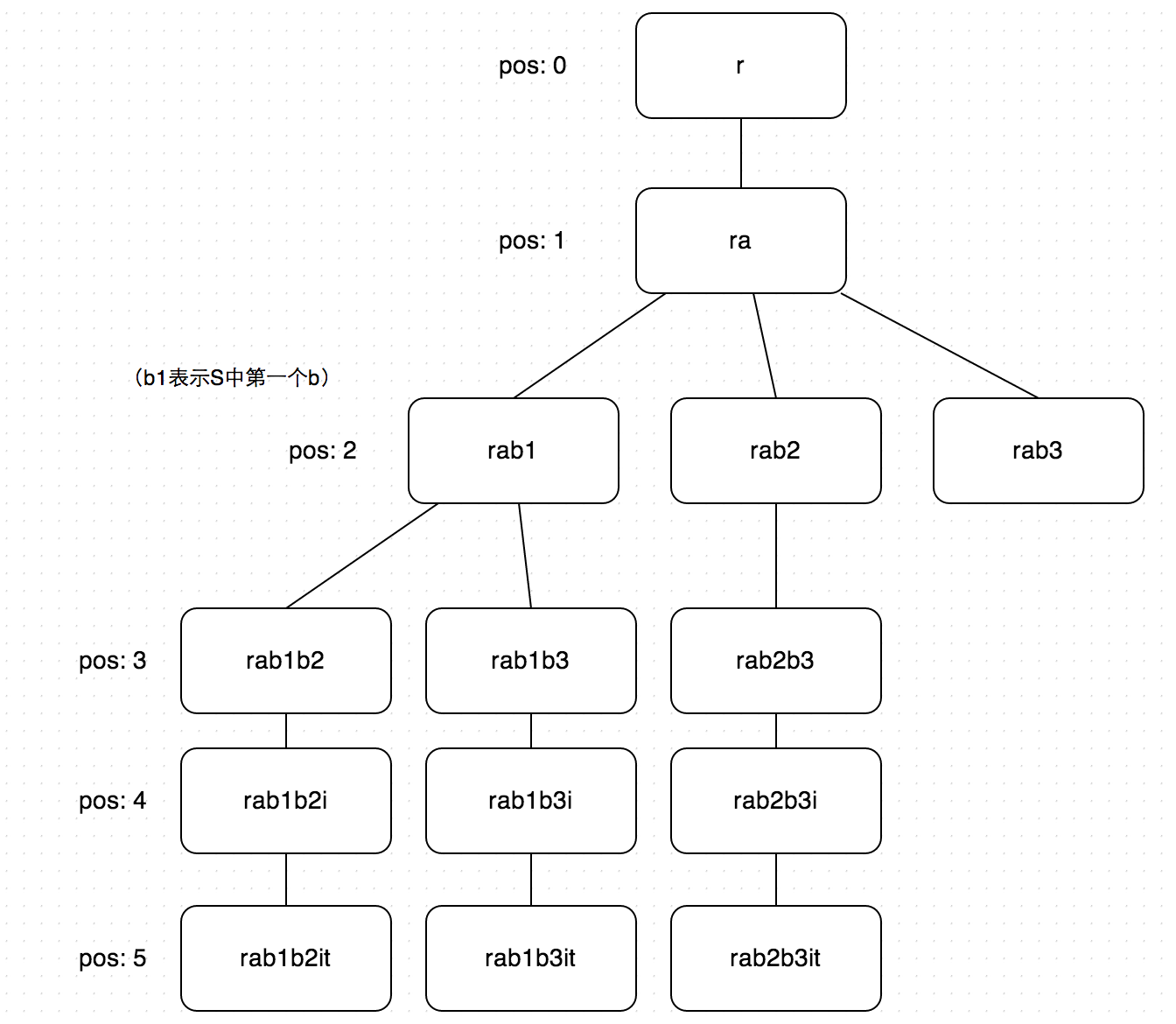问题
给出字符串S和T,计算S中为T的不同的子序列的个数。
一个字符串的子序列是一个由该原始字符串通过删除一些字母(也可以不删)但是不改变剩下字母的相对顺序产生的一个新字符串。如,ACE是ABCDE的一个子序列,但是AEC不是。
这里有一个例子:
S=“rabbbit”,T=“rabbit”
返回值应为3
初始思路
要找出子序列的个数,首先要有找出S中为T的子序列的方法。T是S的子序列,首先其每一个字母肯定会在S中出现,通过遍历T的每一个字母即可完成这个检查。而根据不能乱序的要求,下一个字母在S中出现的位置不能在上一个字母在S中出现的位置之前。由此,我们得到下面的算法:
循环遍历T
如果当前字母在S中,而且在S中的位置大于前一个字母在S中的位置
继续循环
否则
返回
循环结束
确认T为S的子序列
上面的算法用来找S中存不存在唯一的T子序列没有问题,但是如果T中的字母在S中出现多次就不靠谱了。当T中字母多次出现在S时,意味着出现了分支。如S:doggy,T:dog。当我们遍历到g字母时,其实出现了取S中两个不同g字母的分支。看到分支,我们可以想到递归:把循环遍历T的过程改为递归,每次递归调用要处理的T的位置加1,递归结束条件为走到T的结尾。经过这样变化,每次递归条件达成意味着一个子序列出现,这样也达到了我们计算子序列个数的目的。
查找子序列(T,要查找的字母在T中的位置,上一个字母在S中的位置)
如果 要查找的字母在T中的位置 > T的长度
子序列个数加1
返回
如果当前字母在S中
循环遍历S中所有该字母的位置
如果当前位置 <= 上一个字母在S中的位置
继续循环
查找子序列(T,要查找的字母在T中的位置 + 1, 当前位置)
在上面的伪代码中,我们发现判断当前字母是否在S中并获取它在S中的位置这个功能将会被频繁调用。在具体实现时,我们应该联想到使用关联容器(如map)这种查找速度比较快的数据结构(用以字母为下标的数组也可以,查找速度更快。但是需要考虑大小写字母,非英文字母等情况)。字母可以作为关联容器的key,而一个存放位置信息的序列容器(如vector)可以作为关联容器的值。在进行正式计算前,先遍历S生成这个存放信息的关联容器,这样以后我们就不再需要S本身了。最后得到代码如下:

1 class Solution { 2 public: 3 int numDistinct(std::string S, std::string T) 4 { 5 if(T.size() >= S.size()) 6 { 7 if(S == T) 8 { 9 return 1; 10 } 11 else 12 { 13 return 0; 14 } 15 } 16 17 positionInfo_.clear(); 18 count_ = 0; 19 20 for(int i = 0; i < S.size(); ++i) 21 { 22 if(positionInfo_.find(S[i]) == positionInfo_.end()) 23 { 24 positionInfo_[S[i]] = {i}; 25 } 26 else 27 { 28 positionInfo_[S[i]].push_back(i); 29 } 30 } 31 32 FindDistinct(T, 0, -1); 33 34 return count_; 35 } 36 37 private: 38 39 void FindDistinct(std::string& T, int pos, int previousPosInS) 40 { 41 if(pos > T.size() - 1) 42 { 43 ++count_; 44 return; 45 } 46 47 const auto iter = positionInfo_.find(T[pos]); 48 49 for(auto posIter = iter->second.begin(); posIter != iter->second.end(); ++posIter) 50 { 51 if(*posIter <= previousPosInS) 52 { 53 continue; 54 } 55 56 FindDistinct(T, pos + 1, *posIter); 57 } 58 } 59 60 std::map<char, std::vector<int>> positionInfo_; 61 62 int count_; 63 };
提交后Judge Small顺利通过,但是Judge Large超时了。
优化
针对递归计算的优化方法,通过以前题目的分析我们应该比较有经验了:无非就是通过缓存计算结果避免在递归分支中的重复计算。让我们用例子中的S和T来看看递归过程:

可以看到从T的pos为4的地方存在重复计算,由rab1b2已经可以知道取i后只有1种子序列了。这样看起来似乎可以用T的pos作为key,在rab1b2的递归序列中纪录count[4]=1。随后在rab1b3的递归中到达pos3层后不用继续递归pos4层即可查表得到本次的子序列数1,看起来似乎没有问题。但是当我们回到pos为2的rab1时,就可以发现隐藏的错误了,此时我们记录count[3]=2。紧接着我们开始处理pos2层的rab2的递归,经过查表得到子序列个数为count[3]=2。这显然是错误的,rab2继续递归并没有两种子序列。
分析一下错误的原因,我们发现其实某点开始的子序列的个数不但和当时T的位置有关,还和当时在S中选取的字母在S中的位置有关。因此处理完rab1递归时我们的缓存应该为count[2, 2] = 2(2为第一个b在S中的位置)。这样在处理rab2时,[2,3]是没有缓存的,我们通过递归可以得到正确的值1。而前面提到的count[4]=1的缓存变为count[4, 5]=1(5为i在S中的位置),不会影响结果。
现在可以开始实现代码了,由于需要缓存数据,我们得在原来基础上做一些小修改,不再使用成员变量纪录子序列个数,而是使用返回值。这样子才有办法缓存不同递归序列中的中间结果。至于缓存,使用一个std::map<std::pair<int, int>, int>即可。完成后的代码如下:

1 class SolutionV3 { 2 public: 3 int numDistinct(std::string S, std::string T) 4 { 5 if(T.size() >= S.size()) 6 { 7 if(S == T) 8 { 9 return 1; 10 } 11 else 12 { 13 return 0; 14 } 15 } 16 17 positionInfo_.clear(); 18 cachedResult_.clear(); 19 20 for(int i = 0; i < S.size(); ++i) 21 { 22 if(positionInfo_.find(S[i]) == positionInfo_.end()) 23 { 24 positionInfo_[S[i]] = {i}; 25 } 26 else 27 { 28 positionInfo_[S[i]].push_back(i); 29 } 30 } 31 32 return FindDistinct(T, 0, -1); 33 } 34 35 private: 36 37 38 int FindDistinct(std::string& T, int pos, int posInS) 39 { 40 if(pos > T.size() - 1) 41 { 42 return 1; 43 } 44 45 46 int count = 0; 47 int result = 0; 48 49 50 const auto iter = positionInfo_.find(T[pos]); 51 52 53 for(auto posIter = iter->second.begin(); posIter != iter->second.end(); ++posIter) 54 { 55 if(*posIter <= posInS) 56 { 57 continue; 58 } 59 60 CacheKey cacheKey(pos, *posIter); 61 62 if(cachedResult_.find(cacheKey) != cachedResult_.end()) 63 { 64 count += cachedResult_[cacheKey]; 65 continue; 66 } 67 68 result = FindDistinct(T, pos + 1, *posIter); 69 cachedResult_[cacheKey] = result; 70 count += result; 71 } 72 73 return count; 74 } 75 76 std::map<char, std::vector<int>> positionInfo_; 77 78 std::map<std::pair<int, int>, int> cachedResult_; 79 80 typedef std::pair<int, int> CacheKey; 81 };
顺利通过Judge Large。
